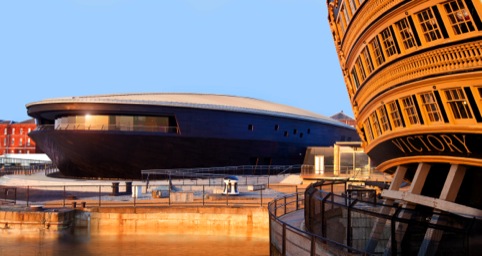A look inside the new Mary Rose Museum
The new Mary Rose Museum is set to open in Portsmouth on 31 May, the culmination of a £27m project with building design by Wilkinson Eyre architects, exhibition work by Land Design Studio and interiors by Pringle Brandon.

A new visitor attraction has been designed around the hulk of the Mary Rose, a 500-year-old Tudor warship, which was raised from the seabed in 1982 and will now be displayed in an ‘air-lock’ controlled environment.
The Mary Rose Museum is located within the Portsmouth Historic Dockyard – from which the ship was launched – and joins The National Museum of The Royal Navy and The Victory at the site.
Visitors will be able to observe the ship’s hull, and a treasure trove of exhumed 16th-century artifacts through a series of windows, which will be removed after a drying process expected to take around four to five years.
An immersive audio-visual experience has been designed by Land Design Studio to greet visitors, telling the story of the ship’s final moments.
Land Design Studio director Peter Higgins says visitors will then move toward a ‘contextual gallery’ where they will find themselves flanked by the length of the wreck and ‘a facsimilie of volumetric spaces’ displaying artifacts.

Source: Portico Marketing
The new Mary Rose Museum has been designed by Wilkinson Eyre Architects and Pringle Brandon
The gallery spaces will run the length of the ship, each at the same level as where decks would once have stood, with artifacts displayed as they might have looked just before the ship sank.
Two ends of the gallery will use screen-based media and displays to introduce historical characters on the ship, including a gunner, cook, carpenter and naval officer, who will be introduced along with found personal belongings.
There will also be the chance to ‘see their faces for the first time’ according to the Portsmouth Historic Dockyard, and visitors will have the opportunity to handle replica weapons and learn about the physical effects of pulling a longbow, which can be seen marked on the bones of an archer. The bones of Hatch, the ships dog have also been preserved.
DNA research, reconstruction and even the use of human remains will be used to build up a picture of life on board the ship.

A painting of the ship’s final moments has been developed into a projection, with stories embedded, which come to life as an interactive mapping device, accessed from workstations. The interface has been developed by Spiral.
The museum will also look to tell the ship’s story in the context of Portsmouth, including how many of the its 500 crew lived locally, and how King Henry VIII watched the ship go down from his vantage point at Southsea Castle.
Higgins says, ‘The project is unique because people will be able to understand how conserved objects fit within the hull – which itself is one of the largest conserved objects in a museum in the world.’
Video:
The identity for the Mary Rose Museum was created by Studio LR in 2011 and designed to challenge the preconception that the museum will only house the remains of the ship.
-
Post a comment




